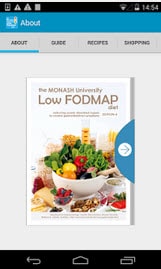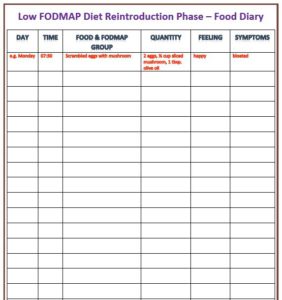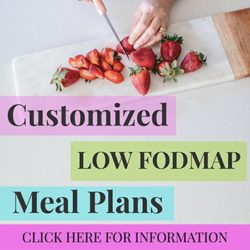If like me you are suffering from Irritable Bowel Syndrome (IBS) and have just been told to follow a low FODMAP diet, you may be feeling a bit overwhelmed, and rightfully so. The low FODMAP diet message is spreading fast and we are starting to see a lot of information about it, but sometimes the information is confusing or contradicting and you don’t know where to start. What is important is that the low FODMAP diet has been proven successful for over 75% of IBS sufferers.
The low FODMAP diet is not a fad diet, it is not a weight loss diet, it is a medically proven diet for people suffering from digestive issues such as IBS. Saying that it is also important to know that the tolerance level to FODMAPs varies from individual to individual. That is why it is always best to get advice from a dietitian who has experience and knowledge of the diet, who can follow and evaluate your progress.
On this blog I follow the advice of the Monash University in Melbourne, after all, they are the founder of this diet and they are continuing to researching FODMAP content in various food.
If you don’t know what FODMAPs are and what the diet is about, I have explained it all in my article: Low-FODMAP Diet for IBS Sufferers Explained.
Here are some tips, if you are new to the low FODMAP diet:
1. Get A Diagnosis From Your Doctor
A lot of people self-diagnose with IBS and put themselves on a low FODMAP diet, but I would not do that. It is important to get a diagnosis from your doctor, also to rule out other more life-threatening illnesses.
2. Consult A Registered Dietitian & low FODMAP Diet expert
I was diagnosed with IBS in 2013, after several medical tests and immediately my GP referred me to a dietitian, who knew about the low FODMAP diet. I am very fortunate, as I live in Australia, I was able to see the dietitian free of charge as part of the management for chronic medical condition, but if I had to pay for the visit I would have still done it. Just make sure that when you book your appointment, you ask your dietitian if she/he is an expert on the low FODMAP diet.
3. Follow The Low FODMAP Elimination Phase
My dietitian advised me to follow a 6 weeks of elimination diet (this was back in 2013, nowadays I have heard that the elimination phase can be also as little as 2 weeks), and she also suggested to invest a few dollars on the Monash University Low FODMAP App for iPhones or for Android Smartphones. For your convenience I have put the links to the app and other products recommended here, at the end of the article in the Useful Resources section.
The elimination diet seemed hard at the beginning as I had to adjust my diet and give up all the food I was used to eat every day, but within a few days I saw a great improvement in my health and that motivated me to continue.
Initially it is important to take one day at the time and do not worry about Sunday lunch at your in-laws next week ;-). Be prepared is the key, plan what you are going to eat each day, your breakfast, lunch, dinner and snacks need to be covered, otherwise you will be tempted to reach for any food you can find. Here are some tips you may want to follow if you are going to eat out, while following a strict low FODMAP elimination diet.
While on the elimination diet, keep a food diary (printable food diary here), that will help to identify any food that does not agree with you, even if it’s low FODMAP (we are all different after all).
By following a strict low FODMAP diet, most people see an improvement within a week or so, it is worth it.
4. follow The Low FODMAP Reintroduction Phase
After 6 weeks, or however long your dietitian has asked you to be on the elimination diet, it is time to reintroduce high FODMAP food, from each FODMAP FOOD GROUP (Sugar Polyols, Lactose, Fructose, Fructans, Galacto-Oligosaccharides also called GOS).
I have written a more detailed article that explains the phases of the low FODMAP diet quite well.
After the reintroduction phase you will still need to monitor the combination of various high FODMAP food in your diet, to understand if you react to bigger amount of that food or to the combination of food from one of the FODMAP groups.
5. The Low FODMAP Maintenance Phase
Well done to getting through the elimination and reintroduction phases of the low FODMAP diet. Now you should have a better idea of what food or entire food group you need to eliminate or reduce, saying that an individual should challenge that food or food group again in the future, as food sensitivity may change. Ideally what you are trying to achieve is a balanced diet that your digestive system can tolerate.
Conclusion
I hope that like me, you will be one of the 75% of people who are able to improve their IBS symptoms by adopting a low FODMAP diet and understand the food or food group that is causing you issues.
The low FODMAP diet it is not a long term diet, once you have gone through the process of elimination and reintroduction you should be able to consume the high FODMAP food that you can tolerate and is not causing you IBS symptoms.
It is important to understand what you can or cannot eat as some high FODMAP food, such as food containing prebiotics (chicory root, raw sauerkraut, asparagus, Jerusalem artichokes, etc.) are very important as they help the good bacteria in your gut to replenish.
I would like to conclude saying that the low FODMAP diet has helped me incredibly and I wish to spread the word around as much as I can.
I am constantly creating low FODMAP recipes and I usually offer them to my subscribers for free before putting them on Amazon, so if you don’t want to miss out on the next low FODMAP recipes, just enter your email on the subscription box on the side of the page.
I’d love to know if you have tried the diet and if it has helped you in any way. Please keep in touch on this blog and on Social Media, you can find me here:
For now I wish you all the very best with the low FODMAP diet.
xo Larah
Useful Resources:
Monash University Low FODMAP App for iPhones
This app is a great help and lists of food that Monash University has tested for FODMAP content. It also contains a recipe book and meal ideas.
Monash University Low FODMAP App for Androids
If you don’t own a smartphone, Monash University has created a hard copy booklet, which can be purchased from their website
Printable Food Diary Elimination Phase
Printable Food Diary Re-challenge Phase
Printable FODMAP Food List from the article “Low FODMAP Diet” (scroll towards the end)
SOME OF THE Best LOW FODMAP DIET books AVAILABLE ON AMAZON:
Disclaimer: I will earn a small commission from the purchase of some of the products recommended on this page and the rest of the site. The commissions help me to cover some of the costs associated with running this site and I am therefore very grateful for your support.










I am also a Type 1 Diabetic. What would you recommend to use for fast acting carbs (glucose) for if/when I go low during the elimination phase?
Hi Jessica, thank you for stopping by and write your question. Unfortunately I am not a health professional and I’m not able to give you advice on this, but I hope you will be able to get an answer from your doctor. I wish you all the best for now and take good care. x Larah